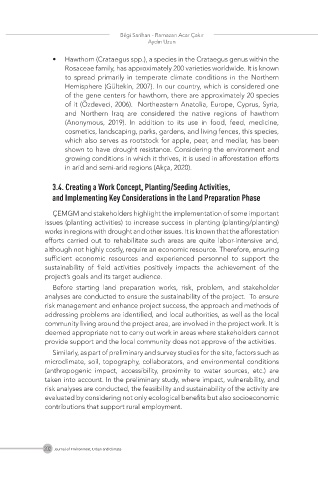Page 215 - Çevre Şehir ve İklim Dergisi İngilizce - Özel Sayı
P. 215
Bilgi Sarihan - Ramazan Acar Çakır
Aydın Uzun
• Hawthorn (Crataegus spp.), a species in the Crataegus genus within the
Rosaceae family, has approximately 200 varieties worldwide. It is known
to spread primarily in temperate climate conditions in the Northern
Hemisphere (Gültekin, 2007). In our country, which is considered one
of the gene centers for hawthorn, there are approximately 20 species
of it (Özdeveci, 2006). Northeastern Anatolia, Europe, Cyprus, Syria,
and Northern Iraq are considered the native regions of hawthorn
(Anonymous, 2019). In addition to its use in food, feed, medicine,
cosmetics, landscaping, parks, gardens, and living fences, this species,
which also serves as rootstock for apple, pear, and medlar, has been
shown to have drought resistance. Considering the environment and
growing conditions in which it thrives, it is used in afforestation efforts
in arid and semi-arid regions (Akça, 2020).
3.4. Creating a Work Concept, Planting/Seeding Activities,
and Implementing Key Considerations in the Land Preparation Phase
ÇEMGM and stakeholders highlight the implementation of some important
issues (planting activities) to increase success in planting (planting/planting)
works in regions with drought and other issues. It is known that the afforestation
efforts carried out to rehabilitate such areas are quite labor-intensive and,
although not highly costly, require an economic resource. Therefore, ensuring
sufficient economic resources and experienced personnel to support the
sustainability of field activities positively impacts the achievement of the
project’s goals and its target audience.
Before starting land preparation works, risk, problem, and stakeholder
analyses are conducted to ensure the sustainability of the project. To ensure
risk management and enhance project success, the approach and methods of
addressing problems are identified, and local authorities, as well as the local
community living around the project area, are involved in the project work. It is
deemed appropriate not to carry out work in areas where stakeholders cannot
provide support and the local community does not approve of the activities.
Similarly, as part of preliminary and survey studies for the site, factors such as
microclimate, soil, topography, collaborators, and environmental conditions
(anthropogenic impact, accessibility, proximity to water sources, etc.) are
taken into account. In the preliminary study, where impact, vulnerability, and
risk analyses are conducted, the feasibility and sustainability of the activity are
evaluated by considering not only ecological benefits but also socioeconomic
contributions that support rural employment.
202 Journal of Environment, Urban and Climate

